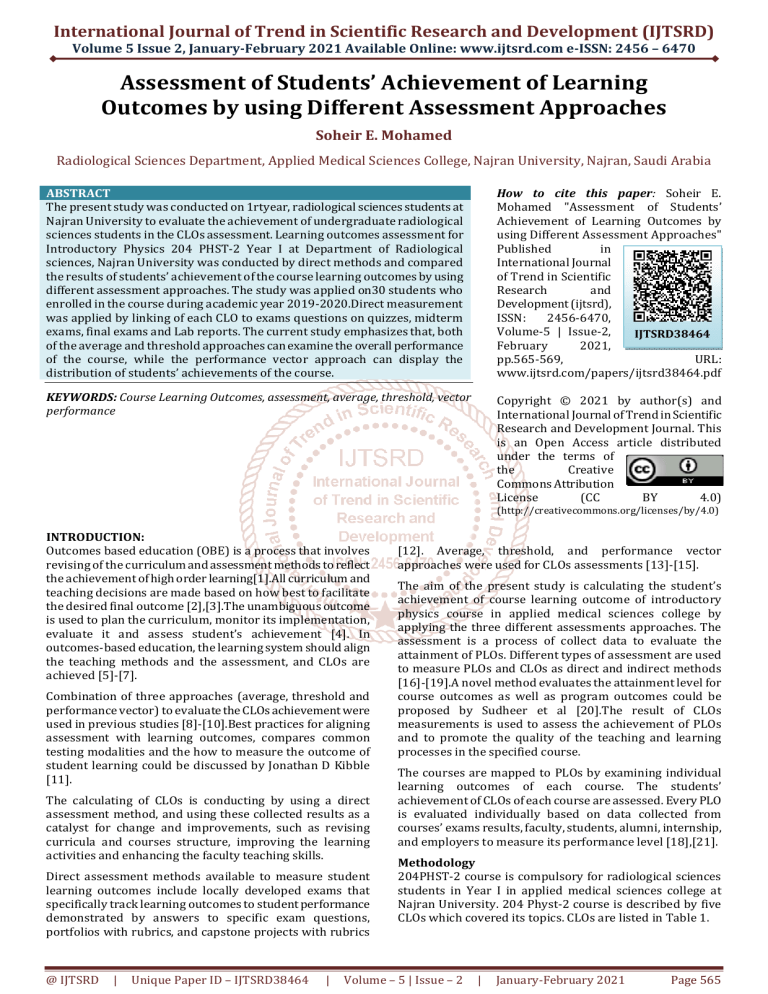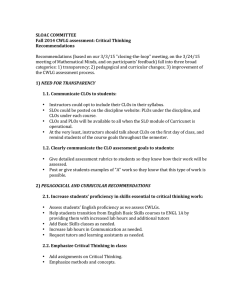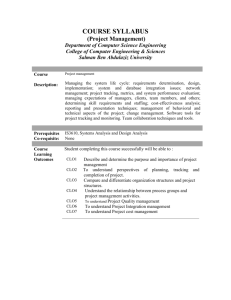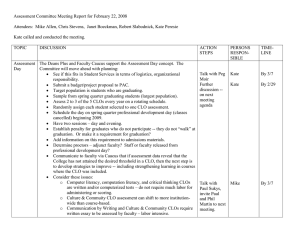
International Journal of Trend in Scientific Research and Development (IJTSRD)
Volume 5 Issue 2, January-February 2021 Available Online: www.ijtsrd.com e-ISSN: 2456 – 6470
Assessment of Students’ Achievement of Learning
Outcomes by using Different Assessment Approaches
Soheir E. Mohamed
Radiological Sciences Department, Applied Medical Sciences College, Najran University, Najran, Saudi Arabia
ABSTRACT
The present study was conducted on 1rtyear, radiological sciences students at
Najran University to evaluate the achievement of undergraduate radiological
sciences students in the CLOs assessment. Learning outcomes assessment for
Introductory Physics 204 PHST-2 Year I at Department of Radiological
sciences, Najran University was conducted by direct methods and compared
the results of students’ achievement of the course learning outcomes by using
different assessment approaches. The study was applied on30 students who
enrolled in the course during academic year 2019-2020.Direct measurement
was applied by linking of each CLO to exams questions on quizzes, midterm
exams, final exams and Lab reports. The current study emphasizes that, both
of the average and threshold approaches can examine the overall performance
of the course, while the performance vector approach can display the
distribution of students’ achievements of the course.
How to cite this paper: Soheir E.
Mohamed "Assessment of Students’
Achievement of Learning Outcomes by
using Different Assessment Approaches"
Published
in
International Journal
of Trend in Scientific
Research
and
Development (ijtsrd),
ISSN:
2456-6470,
Volume-5 | Issue-2,
IJTSRD38464
February
2021,
pp.565-569,
URL:
www.ijtsrd.com/papers/ijtsrd38464.pdf
KEYWORDS: Course Learning Outcomes, assessment, average, threshold, vector
performance
Copyright © 2021 by author(s) and
International Journal of Trend in Scientific
Research and Development Journal. This
is an Open Access article distributed
under the terms of
the
Creative
Commons Attribution
License
(CC
BY
4.0)
(http://creativecommons.org/licenses/by/4.0)
INTRODUCTION:
Outcomes based education (OBE) is a process that involves
revising of the curriculum and assessment methods to reflect
the achievement of high order learning[1].All curriculum and
teaching decisions are made based on how best to facilitate
the desired final outcome [2],[3].The unambiguous outcome
is used to plan the curriculum, monitor its implementation,
evaluate it and assess student’s achievement [4]. In
outcomes-based education, the learning system should align
the teaching methods and the assessment, and CLOs are
achieved [5]-[7].
Combination of three approaches (average, threshold and
performance vector) to evaluate the CLOs achievement were
used in previous studies [8]-[10].Best practices for aligning
assessment with learning outcomes, compares common
testing modalities and the how to measure the outcome of
student learning could be discussed by Jonathan D Kibble
[11].
The calculating of CLOs is conducting by using a direct
assessment method, and using these collected results as a
catalyst for change and improvements, such as revising
curricula and courses structure, improving the learning
activities and enhancing the faculty teaching skills.
Direct assessment methods available to measure student
learning outcomes include locally developed exams that
specifically track learning outcomes to student performance
demonstrated by answers to specific exam questions,
portfolios with rubrics, and capstone projects with rubrics
@ IJTSRD
|
Unique Paper ID – IJTSRD38464
|
[12]. Average, threshold, and performance vector
approaches were used for CLOs assessments [13]-[15].
The aim of the present study is calculating the student’s
achievement of course learning outcome of introductory
physics course in applied medical sciences college by
applying the three different assessments approaches. The
assessment is a process of collect data to evaluate the
attainment of PLOs. Different types of assessment are used
to measure PLOs and CLOs as direct and indirect methods
[16]-[19].A novel method evaluates the attainment level for
course outcomes as well as program outcomes could be
proposed by Sudheer et al [20].The result of CLOs
measurements is used to assess the achievement of PLOs
and to promote the quality of the teaching and learning
processes in the specified course.
The courses are mapped to PLOs by examining individual
learning outcomes of each course. The students’
achievement of CLOs of each course are assessed. Every PLO
is evaluated individually based on data collected from
courses’ exams results, faculty, students, alumni, internship,
and employers to measure its performance level [18],[21].
Methodology
204PHST-2 course is compulsory for radiological sciences
students in Year I in applied medical sciences college at
Najran University. 204 Physt-2 course is described by five
CLOs which covered its topics. CLOs are listed in Table 1.
Volume – 5 | Issue – 2
|
January-February 2021
Page 565
International Journal of Trend in Scientific Research and Development (IJTSRD) @ www.ijtsrd.com eISSN: 2456-6470
CLO1
CLO2
CLO3
CLO4
CLO5
Table 1: CLOs statements
Statement
Identify the units and dimensions of the physical quantities.
Explain the fundamental principles of mechanics, dynamics, energy, and momentum.
Analyze the basic principles of electrical circuits and electromagnetic fields.
Operate basic Laboratory equipment and collect data.
Use graphical models to analyze laboratory data.
Every CLO is assessed by at least by two assessment methods. The variation in the relative weight of each CLO is identified
according to the weight of the topics covered by the CLO of the course. Data was collected on those assessments (exams,
quizzes and lab reports) and analysed to evaluate the scores of students due to their achieving the CLOs. Three assessment
approaches were applied to calculating CLOs of 204 PHST-2 course and the results of 30 enrolled students in that course were
collected and analysed.
From the assessment results, many activities can be organized such as revising and improving the learning outcomes,
developed the learning activities and resources as well as promote the faculty teaching skills [22]-[24].
The first assessment approach is the average approach, where the score average of students should exceed the success criteria,
where the success criteria is (60%) that is according to Najran University examinations rules. The second assessment approach
is the threshold approach, where the high number of the students should exceed the success criteria. In the current study,
100% of the students are expected to achieve ≥60% for a specified assessment. The performance vector is the third approach, it
is based on a performance assessment scoring rubric[13].The combination approaches of average, threshold, and performance
vector was introduced in previous studies [13]-[15].The topics covered are mapped clearly to the CLOs, the assessments
methods and the percentages of coverage of each topic are identified. The assessment methods for CLOs and their relative
weights are presented in the following Table;
Table 2: The relative weight (%) for each CLO and assessment methods
Assessment methods Relative weight Total
Quiz
2.5
CLO1 Midterm written exam
5
17.5
Final written exam
10
Midterm written exam
15
CLO2
15
Final written exam
10
Quiz
2.5
CLO3
22.5
Final written exam
20
Midterm practical exam
6
CLO4
18
Final practical exam
12
Midterm practical exam
4
CLO5 Final practical exam
8
17
Lab reports
5
Total
100
Assessment of the results are provided and actions to be taken are suggested[25].
At the end of the semester in which the course is taught the instructor should prepare the course report.
Results and Discussion
A detailed analysis of students’ achievement of CLOs based on the average approach of 204 PHST-2 course for students
enrolled in academic year 2019-2020 was performed and is tabulated in Table 3.
The results in Table 3 show the achievement of CLOs based on the average approach, where the success criterion equal 60% as
based in Najran University. It is shown from results in Table 3, the students achieved all CLOs of 204 PHST-2 course of first
semester in academic year 2019-2020.
The students achieved CLO5 with the highest value, where they rated 71.796%, while CLO3 was achieved with the lowest value
(61.937%).
Also, the students achieved CLO1, CLO2 and CLO3 with rate equal 66.420%, 67.384% and 67.149% respectively.
On the other hand, the analysis of achievement of CLOs based on the threshold approach of 204 PHST-2 course is tabulated in
Table 4.
The analysis of achievement of CLOs based on the threshold approach of 204 PHST-2 course is tabulated in Table 4
@ IJTSRD
|
Unique Paper ID – IJTSRD38464
|
Volume – 5 | Issue – 2
|
January-February 2021
Page 566
International Journal of Trend in Scientific Research and Development (IJTSRD) @ www.ijtsrd.com eISSN: 2456-6470
Quiz1
CLO1
CLO2
CLO3
CLO4
CLO5
68.32
Quiz1
CLO1
CLO2
CLO3
CLO4
CLO5
60.0
Table 3: Students achievement of CLOs based on the average approach
Midterm
Final
Midterm
Final
Quiz2
(practical Lab Reports
(practical
(written exam)
(written exam)
exam)
exam)
63.166
67.775
63.733
71.034
65.332
58.542
56.527
77.7708
62.917
73.833
78.637
Table 4: Students achievement CLOs based on the threshold approach
Percentage of Students Who Exceed the Threshold Value of 60%
Midterm
Final
Midterm
Final
Quiz2
(practical Lab Reports
(practical
(written exam)
(written exam)
exam)
exam)
46.666
83.33
60.0
66.66
53.333
60.0
66.666
80
60.0
73.333
90.0
CLO (%)
66.420
67.384
61.937
67.149
71.796
CLO (%)
63.332
63.33
56.667
73.33
74.443
Table 4 shows the results of achievement of CLOs based on the threshold approach; the students achieved all the CLOs of 204
PHST-2 course expect CLO3. The students achieved CLO5 with the highest value, where they recorded 74.443%.While CLO3
was achieved with the lowest value equal56.667%. In addition, the students achieved CLO1, CLO2 and CLO4 with rates equal
63.332 %, 63.33 %and 73.33 %respectively. According to the obtained results, the achievement of CLO3 did not reach the
target value and it needs action plan for improvement.
The analysis of achievement of CLOs based on the vector performance approach of 204 PHST-2 course is tabulated in Table 5.
Table 5: Students achievement CLOs based on the vector performance approach
Number and percentage of Students Based on the Performance Level
E ≥80%
M ≥70%
A ≥60%
U <60%
No.
%
No.
%
No.
%
No.
%
CLO1
4
13.333
15
50.0
25
83.333
5
16.666
CLO2
7
23.33
16
53.33
25
83.333
5
16.666
CLO3
4
13.333
11
36.666
20
66.66
10
33.333
CLO4
6
20.00
19
63.33
25
83.333
5
16.666
CLO5
12
40
19
63.333
26
86.66
4
13.333
Table 5 display the results of achievement of CLOs based on the performance vector approach.
The results show that, the students achieved CLO5 with highest value compared to the other CLOs, where 12 students achieved
CLO5 with rate equal ≥80%. So, the percentage of students who join to excellent category is 40 %.
In addition, according to the students’ achievement result of CLO5, only 4 students belong to unsatisfactory categorywith rate
equal 13.33 %.
CLO2 rated the second score of achievement, where the number of students in excellent category is 7 students. They joined to
the excellent category with rate equal 23.33 %, while the number of unsatisfactory students is 5 with rate equal 16.66%.
CLO4 is achieved by 6 students in excellent category with rate equal 20%, while 5 students joined to the unsatisfactory
category with rate equal 16.66%.
CLO1 and CLO3 are achieved by 4 students in excellent category with rate equal 13.13% per each. But, 5 students joined to the
unsatisfactory category with rate equals 16.66% for CLO1, while the ratio of unsatisfactory students is doubled to reach
33.33% for CLO3.As mentioned earlier, CLO1 and CLO3 were achieved with an equal number of excellentstudents, but the
different number of unsatisfactory students. Where the highest number ofunsatisfactory students was related to CLO2.
All the collected results of CLOs assessment are grouped and tabulated in a table 6 and presented in Course Report (Course
Performance Report) [13]-[15].
CLO1
CLO2
CLO3
CLO4
CLO5
@ IJTSRD
|
CLO (%)
Average approach
66.420
67.384
61.937
67.149
71.796
Table 6: Course Performance Report
CLO (%)
CLO % Performance Vector
Threshold approach E
A
M
U
63.332
4 15 25
5
63.33
7 16 25
5
56.667
4 11 20
10
73.33
6 19 25
5
74.443
12 19 26
4
Unique Paper ID – IJTSRD38464
|
Volume – 5 | Issue – 2
|
CLO Attainment
Met
NOT Met
√
√
√
√
√
January-February 2021
Page 567
International Journal of Trend in Scientific Research and Development (IJTSRD) @ www.ijtsrd.com eISSN: 2456-6470
Based on the obtained results, if a CLO average or threshold
score was above the success criteria, and the number of
unsatisfactory students was less than 20%, the CLO is
achieved and it is met the requirement of the CLO [13].
But a CLO average and threshold below the success criteria
or the number of students with unsatisfactory level are more
than 20%, the CLO is not achieved and it is not met the
requirement of the CLO. Accordingly, the CLO needs action
plan for improvement [13].
Table 6 compares the values of CLOs assessment of 204
PHST-2 course. From the findings of Table 6, it is clear that
CLO5 rated the highest values comparing to the other CLOs
by using the three approaches, where CLO5 recorded 71.796
%, 74.443% for average and threshold approaches,
respectively. And it achieved highest number of students
(12) in excellent category (40%), and lowest number of
unsatisfactory students (4) with percentage equal 13.33%.
On the contrary, CLO3 rated the lowest values comparing to
the other CLOs by using the three methods, where it
recorded 61.937%, 56.667 % for average and threshold
methods respectively. And it achieved highest number of
students in unsatisfactory category 10 with percentage
equals 33.333%.
The students’ achievement of CLO1 recorded 66.420%,
63.332 % for average and threshold approach respectively.
And it achieved 4 students in excellent category with rate
equals 31.33% and number of unsatisfactory students is
equal 5 with percentage 16.66%. The students’ achievement
of CLO2 recorded 67.384%, 63.33% for average and
threshold method respectively.
And it achieved 7 students in excellent category, represented
23.333% and 5 unsatisfactory students with percentage
16.66%. The results of assessment of CLO4 recorded 67.149
% and 73.33% for average and threshold method
respectively. And it achieved 6 students in excellent
category, represented 20% and 5 unsatisfactory students
with percentage 16.66%.
Finally, the above results indicate that CLO3 needs action
plan for improvement to closing the loop, this process is
used to improve the teaching and learning quality at course
and program levels.
Conclusion
Overall, different assessment approaches were carried out to
assess the CLOs of 204 PHST-2 course as compulsory course
for radiological sciences students in Year I, and have been
successfully implemented in first semester in 2019-2020.
The obtained results show that the different approaches of
assessment of CLOs have almost consistent results for each
CLO.
In general, the difference in the achievement value of every
CLO by using average and threshold approaches for this
course lies between 2.6 – 6.2%.
The present study agrees with Nurakmal Ahmad et. al [15]
and Alzubaidi et. al [13], where the three different
approaches can assess the achievement of the CLOs through
the direct assessment methods of CLOs. Also, the average
and threshold approaches can identify a limitation rate to
assess the CLOs achievement. Both the average and
threshold approaches can examine the overall performance
of the course, while the performance vector approach can
display the distribution of students’ achievements.
@ IJTSRD
|
Unique Paper ID – IJTSRD38464
|
The findings from this study are based on a comparison
between the collected data of CLOs achievement by using
different assessment approaches. And the results are
enhancing faculty skills on teaching and learning processes
and the assessment experience.
Ethical Approval
After approval of the research proposal by the deanship of
scientific research, it was reviewed by Najran University
ethical review panel. A formal approval to carry out the
study was obtained from the Dean of Applied Medical
Sciences College to conduct the study after an explanation of
its objectives. Informed consent was taken from each
student. All data was confidential and used for the research
purpose only.
Acknowledgments
The authors would like to express their gratitude to the
Ministry of Education and the Deanship of Scientific
Research, Najran University, Kingdom of Saudi Arabia for
their financial and technical support.
References
[1] Tucker, B. 2004. Literature Review: Outcomesfocused Education in Universities. Learning Support
Network, Cambridge University. Retrieved October
19, 2004.
[2]
Spady, W. Organizing for results: the basis of
authentic restructuring and reform. Educational
Leadership. Vol. 46, No. 2 4–8, 1988.
[3]
Spady, W. Outcome-based Education. Belconnen, ACT:
Australian Curriculum Studies Association, 1993.
[4]
R. Eldeeb and N. Shatakumari Outcome Based
Education (OBE) - Trend Review, IOSR Journal of
Research & Method in Education Volume 1, Issue 2 PP
09-11, 2013.
[5]
Crespo, R. M., Najjar, J., Derntl, M., Leony, D.,
Neumann, S., Oberhuemer, P., Totschnig, M., Simon, B.,
Gutierrez, I.&Kloos, C. D. Aligning assessment with
learning outcomes in outcome-based education. IEE
Education Engineering 2010, Madrid Spain, 12391246, 2010.
[6]
Biggs, J. B. and Tang, C. S. Teaching for quality learning
at university: What the student does, e-Book 3rd
edition, McGraw-Hill, 2007.
[7]
Blanford, D., & Hwang, D, Five easy but effective
assessment methods. SIGCSE’03 Proceedings of the
34th SIGCSE technical symposium on Computer
science education, 35, 41-44, 2003.
[8]
Mustaffa, N.A., Zulkifliand, M. and Murat, R.I.Z.,
Measuring course learning outcome for large class of
introductory statistics course. Inter. J. of Innovative
Technol. and Exploring Engng., 8, 7, 382-388, 2019.
[9]
Alzubaidi, L, Measurement of course learning
outcomes for data structure using the combination
approach. Inter. J. of Computer Science and Network
Security, 16, 1, 57-61, 2016.
[10]
Alzubaidi, L., Jabur, I. and Alzubaidi, R., Course
assessment tool using the combination approach.
Proc. World Congr. on Engng. And Computer Science,
San Francisco, USA, 81-85, 2015.
Volume – 5 | Issue – 2
|
January-February 2021
Page 568
International Journal of Trend in Scientific Research and Development (IJTSRD) @ www.ijtsrd.com eISSN: 2456-6470
[11]
Kibble, J. D. Best practices in summative assessment.
Advances in physiology education, 41(1), 110-119,
2017.
[12]
National Commission for Academic Accreditation &
Assessment Handbook for Quality Assurance and
Accreditation Part 2, Version 3, 2015.
[13]
LoayAlzubaidi et al. Course Assessment Tool Using
the Combination Approach, Proceedings of the World
Congress on Engineering and Computer Science 2015
Vol I, 2015.
[14]
Alzubaidi, L., Measurement of course learning
outcomes for data structure using the combination
approach. Inter. J. of Computer Science and Network
Security, 16, 1, 57-61 2016.
[15]
Nurakmal Ahmad et. al, Measuring Course Learning
Outcome for Large Class of Introductory Statistics
Course, International Journal of Innovative
Technology and Exploring Engineering, 2278-3075,
Vol:8 Issue-7S2, 2019.
[16]
ABET Engineering Accreditation Commission, Criteria
for Accrediting Engineering Programs, 2012-2013.
[17]
Mirna Nachouki, Assessing and Evaluating Learning
Outcomes of the Information Systems Program, World
Journal of Educational Research, Vol. 4, No. 4, 2017.
[18]
Mehdi, R., &AbouNaaj, M. Academic Program
Assessment: A Case Study of a Pragmatic Approach.
Creative Education Journal, 4(1), 71-81, 2013.
@ IJTSRD
|
Unique Paper ID – IJTSRD38464
|
[19]
NorlizaAbd.Rahman et al, Assessment Tool of Course
Learning Outcomes for Mechanical Design of Process
Equipment, 6th International Forum on Engineering
Education, Procedia - Social and Behavioral Sciences
102, 116 – 121, 2013.
[20]
Sudheer, K., Sujit, V. V. N., Prasad, N. V. G., &Ravichand,
K. A novel method of learning outcome assessment in
outcome-based education. In 4th International
Conference IEEE on MOOCs, Innovation and
Technology in Education, (pp. 328-331), 2016.
[21]
ErdenekhuuNorinpel et al, Assessment experience on
program learning outcomes, Proceedings of the 14th
International CDIO Conference, Kanazawa Institute of
Technology, Kanazawa, Japan, 2018.
[22]
Aasheim, Gowan, and Reichgelt. Establishing an
Assessment Process for a Computing Program.
Information Systems Education Journal, 5 (1), 2007.
[23]
R. L. Miller and B. M. Olds, Performance Assessment of
EC-2000 Student Outcomes in the Unit Operations
Laboratory, 1999 ASEE Annual Conf. Proc. 1999.
[24]
Bailie, F., Marion, B., & Whitfield, D., How rubrics that
measure outcomes can complete the assessment loop.
Journal of Computing Sciences in Colleges, 25, 15-28,
2010.
[25]
Maxim, B. Closing the loop: Assessment and
accreditation, Journal of Computing Sciences in
Colleges, 20, 7-18, 2004.
Volume – 5 | Issue – 2
|
January-February 2021
Page 569



